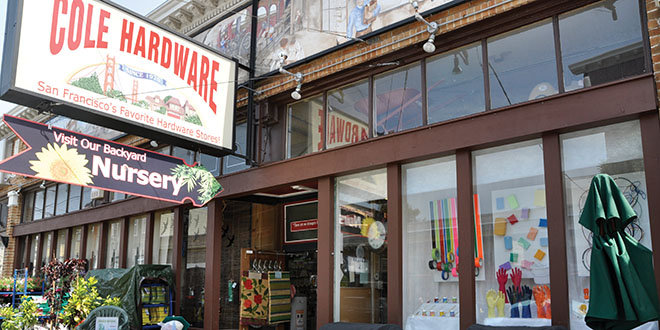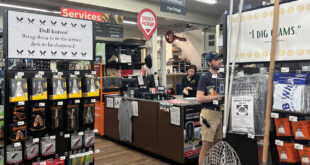In the June issue of Hardware Retailing, we published a feature story highlighting the challenges and opportunities associated with running a home improvement business in an urban environment. In the story, we profiled a retailer from New York and gave you a taste from retailers in Seattle, Chicago and San Francisco. To elaborate, we sat down with David Karp, inventory manager and assistant director of operations at Cole Hardware, who operates six stores in the San Francisco area with his family. In the blurbs below, Karp addresses several elements of doing business and how he and the rest of the staff at Cole Hardware overcome adversities and creatively find ways to set their business a part.
City Ordinances
“There are so many city ordinances that impact our business. There was a huge difference when opening a store in Oakland than the stores in San Francisco in terms of regulations we had to comply with. One example is that in San Francisco, there is a new regulation that says retail businesses need to have all the windows visible so people outside can see into your store. In my opinion, this is a response to big chains like Walgreens that come in and put up huge walls with the lifestyle pictures instead of decorating a window and letting people see into the store. During the process of opening our most recent San Francisco store, we knew about this law. The store is located on the corner of a major street against an ally. We made plans with our co-op to leave the windows on the major street open, offering visibility into the store from the street. Our plan was to use opaque, security glass against the ally. Since you can’t see through these really, we planned to put fixtures along the wall against the ally. But when we took our plans to the city to get approved, they told us we had to lose that whole wall of fixtures to comply with the regulation. That threw a big wrench into our plans, and it took some time to work around that. So that’s one example of many regulations that make doing business in San Francisco more difficult.”
Salesfloor Space
“We’re always trying to maximize the space that we have, but we definitely are constrained with our salesfloor space. Oftentimes we can’t bring in certain categories or we have to bring in a small assortment just because we don’t have the space. The struggle is that it’s easy to bring in new items, but then we have to also focus on discontinuing things that aren’t selling to make room for them. We really try to maximize the space that we have by merchandising everything as tightly as possible. We don’t like to see any pegboard showing and we like to merchandise where ever we can by hanging pegboard from walls or hanging merchandise from the ceiling.”
Inventory Storage
“When it comes to storage, if feels like we never have enough. No matter how much space we have, we always manage to fill it. We want to have storage space to be able to accept large order or make special buys on products that are better priced, but we have to be smart about quantities to minimize the amount of backstock that we have.For the most part, everything is stored at the individual store locations. Some stores have more space than others so they can accommodate larger quantities and we can pull from that store as needed. One of our new stores does have what we’re calling a small distribution center. It’s not actually what you would picture as a distribution center, but it’s a place with more space where we can receive larger orders, divvy them up and send the products where they need to go.”
Parking
“None of our stores have parking lots, and it’s something our customers are always saying they wish we had. Every store has some street parking nearby, whether it be parking meters, free side streets or a paid lot. In reality, the markets we serve are pretty small. Sometimes we like to think the market we serve is a huge section of the city but most of our customers actually reside within seven square blocks around the store. Most people are walking, biking and taking public transportation to and from the store. Sure, some people driving, but the core customers are within a few blocks of the store.”
Delivery
“Last month we started offering same-day delivery for $5 per delivery. In the past, we offered it on the weekends only. We bought an additional van and hired another drive, so now we’re able to offer it daily. We delivery anywhere in the city of San Francisco, and in the neighborhood surrounding our Oakland location.”
Employee Recruitment and Retention
“Finding good workers is always one of our biggest challenges. It’s difficult to find qualified people who are the right fit for our culture and will stick around and deliver the level of customer service our customer expect. This year we’re focused on improving employee retention. Our retention rate is already pretty high. In fact, most employees have been with us for about eight years, and we have several employees who have been with us for more than 20 years. Regardless, we think we can always do better. We’re continuing to have conversations about our benefits to see what more we can offer to make Cole Hardware a great place to work. We feel that if we’re treating our employees right, they’ll want to treat our customers right, so having a happy staff is crucial for us.”
“We get applicants and hire employees who travel from outside the city to work in the San Francisco stores. However, now that we have a store in Oakland, it’s harder for us to get people to come work in the city because Oakland is much more convenient. Some employees commute a long way into the city for work. But on the other side, we also have lots of employees who live in the neighborhoods surrounding our urban stores.”
“Some of our most successful hiring is done through our refer friend and family program. If an employee refers friends or family and they get hired, that employee gets a bonus. If the the friend or family member is still with us in six months, the employee gets another bonus. If they’re still with us is a year, they get even another bonus.”
Security and Theft
“At our downtown store we have a lot of theft, and we need to lock up items where ever we can. We’re very vigilant at all of our stores, but especially at the downtown location when it comes to shoplifters. We try to use the risk as an opportunity to deliver excellent customer service. Even if you think someone is a shoplifter you can’t really do anything about it until they leave the store with something. So what we try to do is kill them with kindness and be sure to let them know we’re available to help. We find a balance of being present, but not overbearing. We don’t want to annoy a potential customer, but we want potential shoplifters to have the feeling that our staff has an eye on what’s happening in the store. One simple tactics we use is walking items to the register when a customer is ready to check out. Our customers like that, and it guarantees security. At the end of the day, we’re always trying to use customer service to deter theft.”
“During new hire orientation we go over our shoplifting guidelines and protocols. If someone feels like they see someone suspicious they’ll make a call on the radio and so everyone is aware and knows to keep an eye out and continue to ask that customer if they need help. While we don’t want to lose anything to theft, we also don’t want our staff chasing after customers when they leave the store. Safety of our employees always takes precedence over the price of merchandise.”
Top Categories
“Our best-selling departments is housewares, and behind that is paint then cleaning products. Housewares isn’t an uncommon thing to find in a hardware store, but the category definitely has a large presence in our stores, considering our footprint. We do our best to listen to what our customers want. On every computer there’s an option for employees to submit lost sales if a customer comes in and couldn’t find what they want. That helps us understand what people want. We also are always bringing in things our customers wouldn’t necessarily expect such as incense, toys and other different niche products. It’s what makes us stand out so when a customer comes in they feel like we have everything.”
Customer Demographics
“We get people from all walks of life coming into the stores, especially at the downtown location. On any given day there might be a homeless person in line behind some big technology business executive. Our core customers are middle-aged, long-time residents of the San Francisco neighborhoods, and most are homeowners. We get a lot of renters and young people too, but our most loyal customers are in their 40’s and 50’s. Attracting younger customers is definitely a challenge for us. In the neighborhoods outside downtown, lots of young families come into the stores, and that’s the main reason why we started carrying toys, which we could be doing a lot more with. The same is true with pet supplies. There are a lot of young families, but I’ve heard that there are more actually more dogs than children in San Francisco.”
Big-box Competition
“There’s one Lowe’s and one Orchard Supply in San Francisco, and there are a few other small locally owned hardware stores. Our biggest competitor is Amazon and other online retailers. Combating Amazon is a never-ending challenge. What sets us a part, though, is our brand, our involvement in the community and the convenience factor. We’re right here for customers to come in and we can help them find exactly what they need and answer questions about projects. We started doing same-day delivery and we also fulfill for Google’s online shopping service where they deliver but we pick, pack and box everything up.”
Customer Communication
“For the past few years we’ve been using this texting system called Instaply. When a customer calls one of our stores from a cellphone, it’ll prompt them to push “one” to get a text message from us. Then, they will get a text from Cole Hardware and instead of talking to us on the phone, the customer can text our staff and send pictures back and forth, etc. That’s been a popular service for us. We don’t have exact demographic information, but I think this tool is most popular amongst the younger, tech-savvy generation. They seem to be more comfortable texting than talking, so it works out. This tool has a lot of potential as the younger generation becomes a larger part of our customer base.”
Community Engagement
“There are many things that make Cole Hardware unique, but the biggest are community engagement and being an employee-centric organization. We private label wine and donate cases to community groups who are having events, auctions or similar types of events. Once a month we also have a happy hour in the store where we serve our wine and our private label chocolate and offer deals. We’re always trying to do something different and interesting to drive new foot traffic into the stores.”
 Hardware Retailing The Industry's Source for Insights and Information
Hardware Retailing The Industry's Source for Insights and Information








